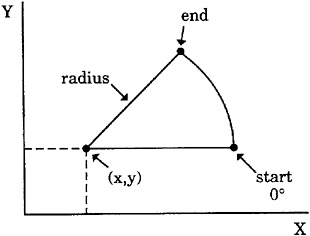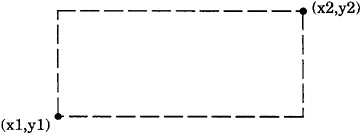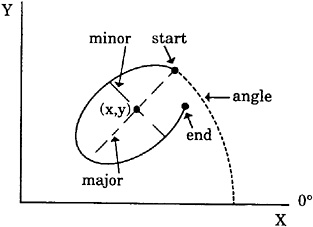GDRAW Functions
GDRAW functions create graphics elements. Each GDRAW operator is associated with a set of GSET operators that control its attributes. For example, the color , height, and font for the GDRAW( TEXT , ) function are controlled by GSET( TEXCOLOR , ), GSET( TEXHEIGHT , ), and GSET( TEXFONT , ), respectively. For a complete list of the attributes associated with each GDRAW function, see Table 49.2 on page 1364. The complete graph is displayed after the GRAPH( UPDATE , ) function is submitted.
When using GDRAW functions, remember the following:
-
All arguments must be specified.
-
All arguments are specified as variables or constants. If you express an argument as a variable, the variable must be initialized .
-
All character arguments that are expressed as character strings must be enclosed in quotes.
-
All character variable names used as arguments must be declared in a LENGTH statement.
-
All character constants must be enclosed in single or double quotes.
GDRAW functions:
-
ARC
-
BAR
-
ELLARC
-
ELLIPSE
-
FILL
-
IMAGE
-
LINE
-
MARK
-
MESSAGE
-
PIE
-
TEXT
ARC
Draws a circular arc
Operating States: SGOP
Return Codes: 0, 4, 61, 86
Syntax
return-code-variable = GDRAW( ARC , x, y, radius, start, end );
Description
The GDRAW( ARC , ) function draws a circular arc. The line attributes and bundles affect the appearance of this primitive. See Table 49.2 on page 1364 for a list of these attributes. Figure 50.2 on page 1447 illustrates the arguments used with GDRAW( ARC , ).

Figure 50.2: Arguments Used with the GDRAW( ARC , ) Function
Argument Definitions
| x | numeric constant or numeric variable name ; specifies the x coordinate of the position of the arc on the display; x coordinates are in units based on the current window system. |
| y | numeric constant or numeric variable name; specifies the y coordinate of the position of the arc on the display; y coordinates are in units based on the current window system; |
| radius | numeric constant or numeric variable name; the arc radius size is in units based on the current window system. |
| start | numeric constant or numeric variable name; the starting angle of the arc is in degrees, with 0 degrees at 3 o clock. |
| end | numeric constant or numeric variable name; the ending angle of the arc is in degrees, with 0 degrees at 3 o clock. |
See Also
-
ELLARC on page 1449
-
PIE on page 1455
-
LINCOLOR on page 1476
-
LININDEX on page 1477
-
LINREP on page 1478
-
LINTYPE on page 1479
-
LINWIDTH on page 1479
BAR
Draws a rectangle
Operating States: SGOP
Return Codes: 0, 4, 76, 79, 80, 86
Syntax
return-code-variable = GDRAW( BAR , x1, y1, x2, y2 );
Description
The GDRAW( BAR , ) function draws a rectangular bar whose sides are parallel to the sides of the display area. The fill attributes and bundles affect the appearance of this graphics element. See Table 49.2 on page 1364 for a list of these attributes. Figure 50.3 on page 1448 illustrates the arguments used with GDRAW( BAR , ).

Figure 50.3: Points that Draw a Bar
Argument Definitions
| x1 | numeric constant or numeric variable name; refers to the x coordinate of one corner of the bar. |
| y1 | numeric constant or numeric variable name; refers to the y coordinate of one corner of the bar. |
| x2 | numeric constant or numeric variable name; refers to the x coordinate of the corner of the bar that is diagonally opposite to the corner of ( x1 , y1 ). |
| y2 | numeric constant or numeric variable name; refers to the y coordinate of the corner of the bar that is diagonally opposite to the corner of ( x1 , y1 ). |
See Also
-
FILL on page 1451
-
FILCOLOR on page 1469
-
FILINDEX on page 1470
-
FILREP on page 1470
-
FILTYPE on page 1473
-
FILSTYLE on page 1471
-
HTML on page 1475
ELLARC
Draws an elliptical arc
Operating States: SGOP
Return Codes: 0, 4, 61, 86
Syntax
return-code-variable = GDRAW( ELLARC , x, y, major, minor, start, end, angle );
Description
The GDRAW( ELLARC , ) function draws a hollow section of an ellipse. The line attributes and bundles affect the appearance of this primitive. See Table 49.2 on page 1364 for a list of these attributes. Figure 50.4 on page 1449 illustrates the arguments used with GDRAW( ELLARC , ) and GDRAW( ELLIPSE , ).

Figure 50.4: Arguments Used with GDRAW( ELLARC , ) function and GDRAW( ELLIPSE , ) function
Argument Definitions
| x | numeric constant or numeric variable name; x coordinates are in units based on the current window system. |
| y | numeric constant or numeric variable name; y coordinates are in units based on the current window system. |
| major | numeric constant or numeric variable name; the major axis lengths for the elliptical arc. |
| minor | numeric constant or numeric variable name; the minor axis lengths for the elliptical arc. |
| start | numeric constant or numeric variable name; the starting angle from the major axis, in degrees, for the elliptical arc with 0 degrees beginning at the major axis. |
| end | numeric constant or numeric variable name; the ending angle from the major axis, in degrees, for the elliptical arc with 0 degrees at 3 o clock. |
| angle | numeric constant or numeric variable name; the angle that the major axis of the elliptical arc has to 0 degrees (with 0 degrees at 3 o clock). |
See Also
-
ELLIPSE on page 1450
-
LINCOLOR on page 1476
-
LINTYPE on page 1479
-
LINWIDTH on page 1479
-
LINREP on page 1478
-
LININDEX on page 1477
ELLIPSE
Draws an ellipse
Operating States: SGOP
Return Codes: 0, 4, 76, 79, 80, 86
Syntax
return-code-variable = GDRAW( ELLIPSE , x, y, major, minor, start, end, angle );
Description
The GDRAW( ELLIPSE , ) function draws a filled section of an ellipse. The fill attributes and bundles affect the appearance of this primitive. See Table 49.2 on page 1364 for a list of these attributes. Figure 50.4 on page 1449 illustrates the arguments used with GDRAW( ELLARC , ) and GDRAW( ELLIPSE , ).
Argument Definitions
| x | numeric constant or numeric variable name; the x coordinate of the position of the ellipse on the display. |
| y | numeric constant or numeric variable name; the y coordinate of the position of the ellipse on the display. |
| major | numeric constant or numeric variable name; the major axis length for the ellipse. |
| minor | numeric constant or numeric variable name; the minor axis length for the ellipse. |
| start | numeric constant or numeric variable name; the starting angle for the ellipse from the major axis, with 0 degrees beginning at the major axis. |
| end | numeric constant or numeric variable name; the ending angle for the ellipse from the major axis, with 0 degrees at 3 o clock. |
| angle | numeric constant or numeric variable name; the angle that the major axis of the ellipse has to 0 degrees, with 0 degrees at 3 o clock. |
See Also
-
ELLARC on page 1449
-
FILCOLOR on page 1469
-
FILINDEX on page 1470
-
FILREP on page 1470
-
FILTYPE on page 1473
-
HTML on page 1475
FILL
Draws a filled area
Operating States: SGOP
Return Codes: 0, 4, 76, 79, 80, 86, 100, 301
Syntax
return-code-variable = GDRAW( FILL , n, x-values, y-values );
Description
The GDRAW( ILL ) function draws a filled polygon. The fill attributes and bundles affect the appearance of this primitive. See Table 49.2 on page 1364 for a list of these attributes.
Note: All of the x coordinates are listed in the function first, followed by the y coordinates. This primitive takes the first n values and stores them as x coordinates. The next n values are stored as y coordinates.
Argument Definitions
| n | numeric constant or numeric variable name; the number of vertices ( x and y pairs) in the polygon. You can specify a missing value (.) for n .If n is missing, the number of vertices is computed from the number of x and y arguments. |
| x-values | list of numeric constants, variables, or OF arguments that describe the x coordinates for the vertices in units based on the current window system. |
| y-values | list of numeric constants, variables, or OF arguments that describe the y coordinates for the vertices in units based on the current window system. |
See Also
-
BAR on page 1448
-
FILCOLOR on page 1469
-
FILINDEX on page 1470
-
FILREP on page 1470
-
FILTYPE on page 1473
-
FILSTYLE on page 1471
-
HTML on page 1475
IMAGE
Displays an image
Operating State: SGOP
Return Codes: 0, 150
Syntax
return-code-variable =GDRAW( IMAGE , external-file , x1 , y1 , x2 , y2 , style );
Description
The GDRAW( IMAGE , ) function displays the specified image within opposing pairs of coordinates. The format of the external image file varies between operating environments. The (x1, y1) coordinate pair specifies one corner of the image, and the (x2, y2) coordinate pair specifies the opposite corner of the image. The style parameter must be either TILE to copy the image as many times as necessary to fill the area, or FIT to stretch one instance of the image to fill the area.
LINE
Draws a polyline
Operating States: SGOP
Return Codes: 0, 4, 61, 86, 100, 301
Syntax
return-code-variable =GDRAW( LINE , n, x-values, y-values );
Description
The GDRAW( LINE ) function draws one line, a series of connected lines, or a dot. The line attributes and bundles affect the appearance of this primitive. See Table 49.2 on page 1364 for a list of these attributes.
Note: All of the x coordinates are listed in the function first, followed by the y coordinates. This primitive takes the first n values and stores them as x coordinates and the next n values and stores them as y coordinates.
Argument Definitions
| n | numeric constant or numeric variable name; the number of vertices ( x and y pairs) in the polygon. You can specify a missing value (.) for n . If n is missing, the number of vertices is computed from the number of x and y pairs. |
| x-values | list of numeric constants, variables, or OF arguments that describe the x coordinates for the vertices in units based on the current window system. |
| y-values | list of numeric constants, variables, or OF argument lists that describe the y coordinates for the vertices in units based on the current window system. |
See Also
-
FILCOLOR on page 1469
-
LININDEX on page 1477
-
LINREP on page 1478
-
LINTYPE on page 1479
-
LINWIDTH on page 1479
MARK
Draws a polymarker
Operating States: SGOP
Return Codes: 0, 4, 65, 86, 100, 301
Syntax
return-code-variable =GDRAW ( MARK , n, x-values, y-values );
Description
The GDRAW( MARK , ) function draws a series of symbols. The marker attributes and bundles affect the appearance of this primitive. See Table 49.2 on page 1364 for a list of these attributes. Refer to the MARTYPE on page 1483 for a list of symbols that you can draw with GDRAW( MARK , ).
Note: All of the x coordinates are listed in the function first, followed by the y coordinates. This primitive takes the first n values and stores them as x coordinates and the next n values and stores them as y coordinates.
Argument Definitions
| n | numeric constant or numeric variable name; the number of times the symbol is drawn. You can specify a missing value (.) for n . If n is missing, the number of vertices is calculated from the number of x and y pairs. |
| x-values | list of numeric constants, variables, or OF arguments that describe the x coordinates of the symbols in units based on the current window system. |
| y-values | list of numeric constants, variables, or OF arguments that describe the y coordinates of the symbols in units based on the current window system. |
See Also
-
TEXT on page 1456
-
HTML on page 1475
-
MARCOLOR on page 1480
-
MARINDEX on page 1481
-
MARREP on page 1482
-
MARTYPE on page 1483
MESSAGE
Prints a message in the SAS log
Operating States: All
Return Codes:
Syntax
return-code-variable =GDRAW( MESSAGE , message );
Description
The GDRAW( MESSAGE , ) function prints a message in the SAS log. This function may be used for debugging applications or for printing custom messages for your application.
Argument Definitions
| message | character string enclosed in quotes or character variable name; the text to be printed in the log. |
See Also
-
MESSAGE on page 1485
-
GPRINT on page 1402
PIE
Draws a filled circle or section of a filled circle
Operating States: SGOP
Return Codes: 0, 4, 76, 79, 80, 86
Syntax
return-code-variable =GDRAW( PIE , x, y, radius, start, end );
Description
The GDRAW( PIE , ) function draws a filled section of a circular arc. The fill attributes and bundles affect the appearance of this primitive. See Table 49.2 on page 1364 for a list of these attributes.
Argument Definitions
| x | numeric constant or numeric variable name; x coordinates are in units based on the current window system. |
| y | numeric constant or numeric variable name; y coordinates are in units based on the current window system. |
| radius | numeric constant or numeric variable name; the pie radius size in units based on the current window system. |
| start | numeric constant or numeric variable name; the starting angle of the pie, with 0 degrees at 3 o clock on the unit circle. |
| end | numeric constant or numeric variable name; the ending angle of the pie, with 0 degrees at 3 o clock on the unit circle. |
See Also
-
ARC on page 1446
-
FILCOLOR on page 1469
-
FILINDEX on page 1470
-
FILREP on page 1470
-
FILTYPE on page 1473
-
FILSTYLE on page 1471
-
HTML on page 1475
TEXT
Draws a text string
Operating States: SGOP
Return Codes: 0, 4, 69, 86
Syntax
return-code-variable =GDRAW( TEXT , x, y, string );
Description
The GDRAW( TEXT , ) function draws a text string. The text attributes and bundles affect the appearance of this primitive. See Table 49.2 on page 1364 for a list of these attributes.
Argument Definitions
| x | numeric constant or numeric variable name; x coordinates are in units based on the current window system. |
| y | numeric constant or numeric variable name; y coordinates are in units based on the current window system. |
| string | character string enclosed in quotes or character variable name; a set of characters to be drawn on the output beginning at position ( x , y ). |
See Also
-
MARK on page 1453
-
HTML on page 1475
-
TEXCOLOR on page 1488
-
TEXINDEX on page 1490
-
TEXREP on page 1492
-
TEXHEIGHT on page 1490